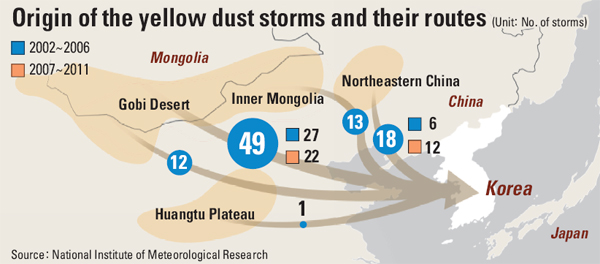Yellow dust season to be longer, more severe

Hwangsa season is upon us - that time of year when the sky turns yellow and your throat gets extremely sore because of the dust-filled air.
Hwangsa, or yellow sand in Korean, is the season when yellow dust storms from Mongolia and China blow east and blanket Korea.
Concerns are rising as the sandstorms are expected to occur more frequently this year. Regions that generate the yellow dust are experiencing increased desertification as a result of industrialization and logging.
According to the Ministry of Environment, the average number of days Korea is hit with yellow dust per year is growing.
In the 1980s, storms hit Korea for an average of 3.9 days, while in the 1990s, the number of days jumped to 7.7. From 2000 to 2011, Korea experienced yellow storms 11.8 days per year on average.
The density of the dust particles has also become more severe in recent years. According to the Ministry of Environment, the hourly average of dust density during yellow sand season was 933 micrograms per cubic meter in 2008. The figure jumped to 1,157 micrograms per cubic meter in 2009 and 1,354 micrograms per cubic meter last year.
According to the Korea Meteorological Administration, this year Korea will see yellow dust not only more frequently, but sandstorms will be concentrated in the months of April and May instead of March to May and could last up until the monsoon season in July.
The first sandstorm that hit Korea’s western regions and Jeju Island was from China’s Gobi Desert and Inner Mongolia on March 24. The density measurement was 152 micrograms per cubic meter in Jeju. A special warning is given when dust density is over 800 micrograms per cubic meter.
Last year, Korea saw its first sandstorm on March 19. “The yellow dust coming to Korea passes through China, which produces harmful emissions due to its urban growth,” said an official from the KMA.
“The dust storms hitting Korea will include a high level of heavy metals, viruses and microorganisms that can cause asthma, bronchitis, conjunctivitis and skin problems.”
Dust particles from the desert combine with factory emissions in China before they reach Korea.
A recent study by the National Institute of Meteorological Research also showed that Korea is experiencing more dust from the Manchurian region in northeastern China.
According to the institute, yellow dust from Manchuria can arrive on the Korean Peninsula within 24 hours. As for dust storms occurring from the Gobi Desert in Mongolia, they take more than two days to make it here.
Based on the institute’s study of the origins of the yellow dust coming into Korea over the last 10 years from 2002 and 2011, of the 93 storms that flowed into the peninsula, 53 percent came from the Gobi Desert and Inner Mongolia.
There were 18 storms from Manchuria over the same period, accounting for 19 percent of the total number of storms that hit Korea. In the first five years of the period, Manchuria-originated storms took up merely 16 percent, however, in the latter five years, it increased to 22 percent.
“The vast cornfields of the Manchurian region are exposed during the spring season before planting begins, which creates opportunities for dust if the weather is dry and there are strong winds,” said Jeon Young-shin, a researcher from the weather institute.
“The Manchurian region is witnessing rapid desertification with the increase in population, creating strong yellow dust storms harmful to the human body.”
According to the official, dust storms from Manchuria pass through North Korea. The North’s dearth of communication with the South makes it harder for South Korean meteorologists to predict them.
On April 8, 2006, South Korea suffered one of its worst dust storms, and weather officials were not able to predict it. The KMA later explained that it wasn’t sure of the storm’s direction because it passed through the North.
“When the sky is cloudy, it is difficult to forecast yellow dust using only a satellite. Meteorologists need to constantly check the level of dust particles on the ground,” said Chung Yong-seung, director of the Korea Center for Atmospheric Environment Research.
“But South Korean meteorologists are not notified of dust particles passing over North Korean land.”
The South Korean government installed a weather observation station on the North’s Mount Kumgang in August 2007 as part of a South-North cooperative meteorological project and had received information on dust particles the following month.
However, due to the sour relationship between the two countries, the project was halted in May 2008.
By Lee Eun-joo, Kang Chan-su [angie@joongang.co.kr]










with the Korea JoongAng Daily
To write comments, please log in to one of the accounts.
Standards Board Policy (0/250자)